💓博主CSDN主页:麻辣韭菜-CSDN博客💓
⏩专栏分类:C++知识分享⏪
🚚代码仓库:C++高阶🚚
🌹关注我🫵带你学习更多C++知识
🔝🔝
前言
C++二叉搜索树 这篇讲解了搜索二叉树的实现的,本篇从实战出发,让大家更好的掌握和理解二叉树的!!!!
1. 二叉树创建字符串。606. 根据二叉树创建字符串 - 力扣(LeetCode)
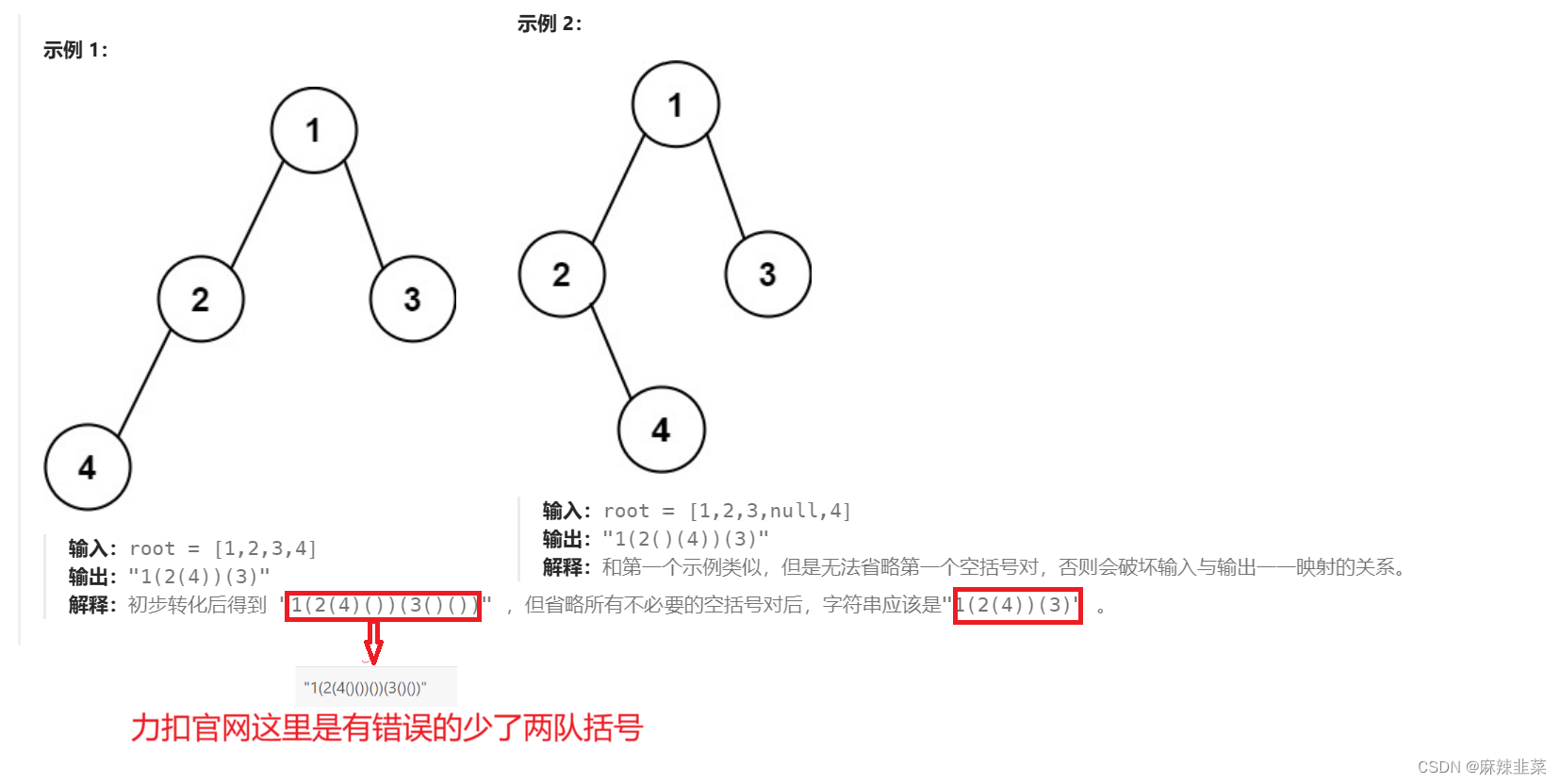
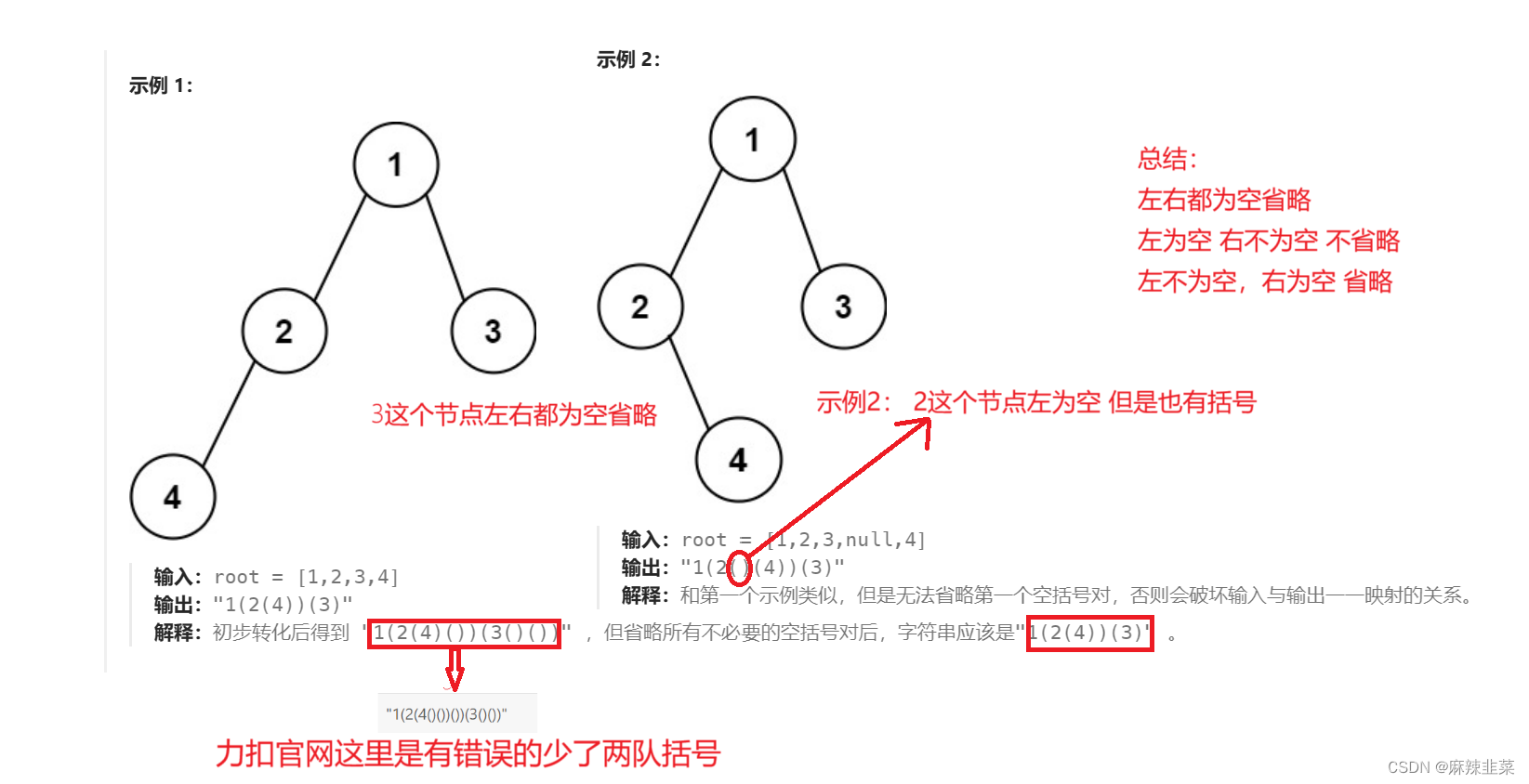
找出规律,我们就好办了 直接代码演示。
class Solution {
public:string tree2str(TreeNode* root) {if(root == nullptr) //根为空 直接返回空串!return "";string str = to_string(root->val); //外面解释这个函数//结合 刚才的3点总结 左右都为空不加括号,左为空是要加括号的。 if(root->left || root->right){str += '(';str += tree2str(root->left);str += ')';}if(root->right){str += '(';str += tree2str(root->right);str += ')';}return str;}
};
to_string是 C++ 标准库中的一个函数,它定义在<string>头文件中。这个函数用于将一个数值类型(如int、double等)转换为其对应的字符串表示形式。 在给出的代码片段中,to_string(root->val)被用来将TreeNode对象的val属性(假设是一个数值类型)转换为一个字符串。这样,就可以将该字符串与其他部分拼接起来,形成最终的树形结构字符串表示。 例如,如果root->val是整数3,那么to_string(root->val)将返回字符串"3"。 简而言之,to_string函数在 C++ 中用于数值到字符串的转换。在你的代码中,它被用来将树节点的值转换为字符串,以便构建树结构的字符串表示。
这里有点难理解是左不为空,右为空。按照上面条件不是就错了吗?
我们按照题的要求前序遍历,是先根在左然后右 看递归展开图
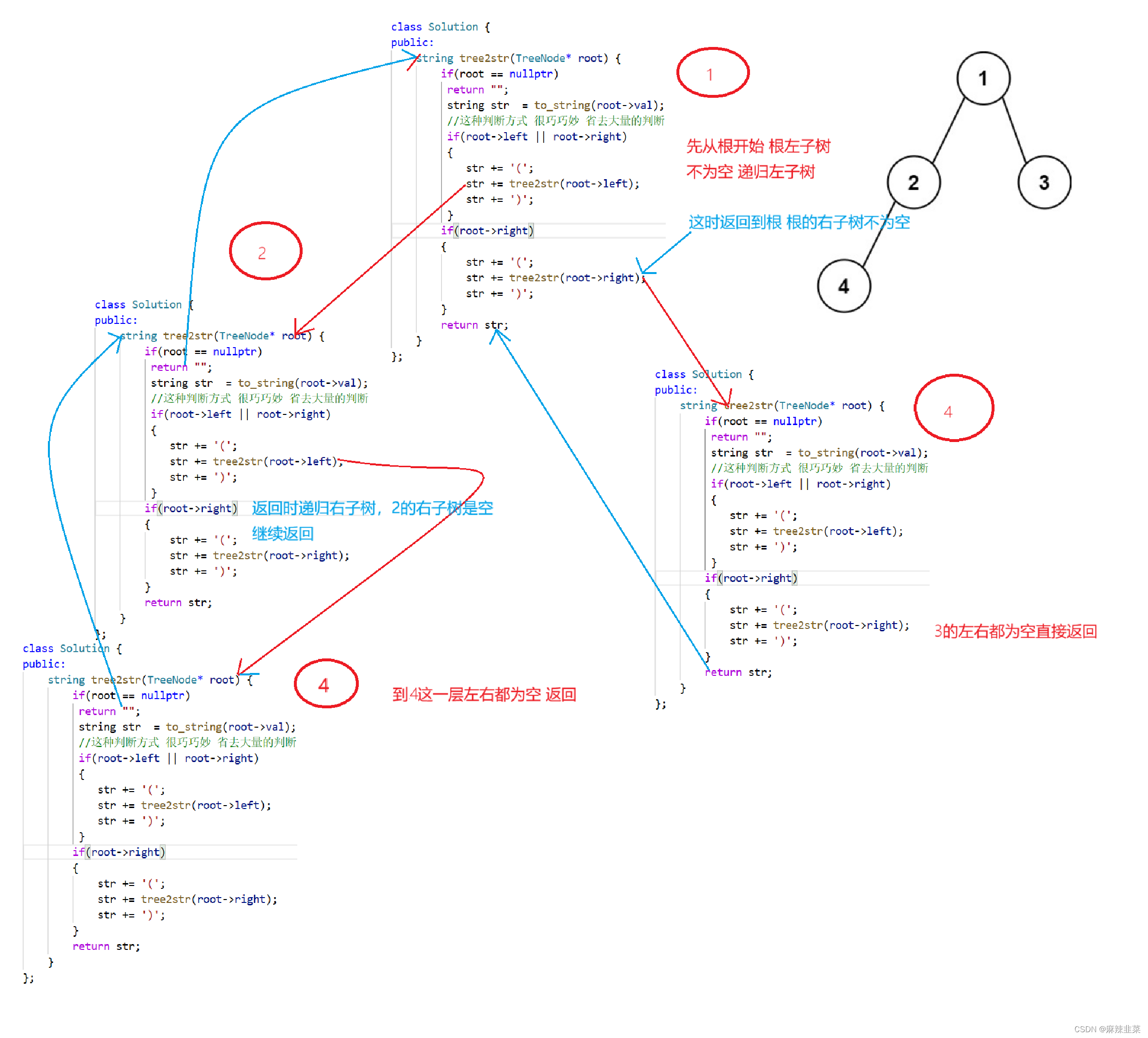
递归是一层一层展开,如果左不为空,右为空它们就会像上图那样一直找到左为空为止,
这时在递归右子树 。
2. 二叉树的分层遍历1。102. 二叉树的层序遍历 - 力扣(LeetCode)

解题思路 :我们创建一个队列,前序遍历这个数组,每遍历一次,就进队列一次,
根据队列的性质先进先出。就解决了!!!
class Solution {
public:vector<vector<int>> levelOrder(TreeNode* root) {queue<TreeNode* > q; //创建队列int levelSize = 0; //层数变量vector<vector<int>> vv;if(root) //节点不为空进队列{q.push(root);levelSize = 1; //为什么是1 根就只有一个。}while(!q.empty()) //如果队列不为空{vector<int> v;while(levelSize){TreeNode* front = q.front();q.pop();//出队列v.push_back(front->val); //把队顶的数据压进顺序表V//带入下一层if(front->left)q.push(front->left);if(front->right)q.push(front->right);--levelSize;}vv.push_back(v); //把每一层出完,压进二维的顺序表levelSize = q.size();//更新每一层,数据有多少个。}return vv;}
};
3. 二叉树的分层遍历2。107. 二叉树的层序遍历 II - 力扣(LeetCode)

这个题没什么好说的,来个投机的,把第二题逆置再返回。
class Solution {
public:vector<vector<int>> levelOrderBottom(TreeNode* root) {queue<TreeNode* > q; //创建队列int levelSize = 0; //层数变量vector<vector<int>> vv;if(root) //节点不为空进队列{q.push(root);levelSize = 1; //为什么是1 根就只有一个。}while(!q.empty()) //如果队列不为空{vector<int> v;while(levelSize){TreeNode* front = q.front();q.pop();//出队列v.push_back(front->val); //把队顶的数据压进顺序表V//带入下一层if(front->left)q.push(front->left);if(front->right)q.push(front->right);--levelSize;}vv.push_back(v); //把每一层出完,压进二维的顺序表levelSize = q.size();//更新每一层,数据有多少个。}reverse(vv.begin(),vv.end()); //用迭代器逆置return vv;}};
4. 给定一个二叉树, 找到该树中两个指定节点的最近公共祖先 。
236. 二叉树的最近公共祖先 - 力扣(LeetCode)

解题思路 根据解释,我们可以得出 一个在我的左子树,一个在我的右子树。我就是公共祖先。那我们可以用路径相交思路来解决,比如7和0的公共祖先。根据递归深度路径大小,
让深度更深的那个先走,等它们深度一样时,同时再走,最后相等的那个值就是公共祖先。
class Solution {
public:bool GetPath(TreeNode* root,TreeNode* x,stack<TreeNode*>& path){if(root == nullptr) //根都为空了 还找个屁{return false;}//不为空进栈path.push(root);if(root == x) // 找到了{return true;}if(GetPath(root->left,x,path)) //左递归{return true;}if(GetPath(root->right,x,path))//右递归{return true;}path.pop();//刚才条件说 一个在我的右,一个在我的左,这里左右都为空了肯定不是祖先,出栈。return false;}TreeNode* lowestCommonAncestor(TreeNode* root, TreeNode* p, TreeNode* q) {stack<TreeNode*> pPath,qPath; //这里用栈 先进后出GetPath(root,p,pPath);GetPath(root,q,qPath);while(qPath.size() != pPath.size()){if(qPath.size()>pPath.size())qPath.pop();elsepPath.pop();}while(qPath.top() != pPath.top()){qPath.pop();pPath.pop();}return qPath.top();}
};
5. 二叉树搜索树转换成排序双向链表。二叉搜索树与双向链表_牛客题霸_牛客网 (nowcoder.com)

解题思路:中序遍历,然后 改链接方向,如何改?根的左就是prev。 右怎么改?记录父亲节点,根的右就是父亲节点 以4举例:4的左为空,那它连接就是nullptr,再看右为空返回上一层这时父亲连接它的右
class Solution {
public:void InorderConvert(TreeNode* cur, TreeNode*& prev){if(cur == nullptr)return ;InorderConvert(cur->left,prev);cur->left = prev;if(prev)prev->right = cur;prev = cur;InorderConvert(cur->right,prev);}TreeNode* Convert(TreeNode* pRootOfTree){TreeNode* prev = nullptr;InorderConvert(pRootOfTree,prev);TreeNode* head = pRootOfTree;while (head && head->left) {head = head->left;}return head;}};
6. 根据一棵树的前序遍历与中序遍历构造二叉树。 105. 从前序与中序遍历序列构造二叉树 - 力扣(LeetCode)
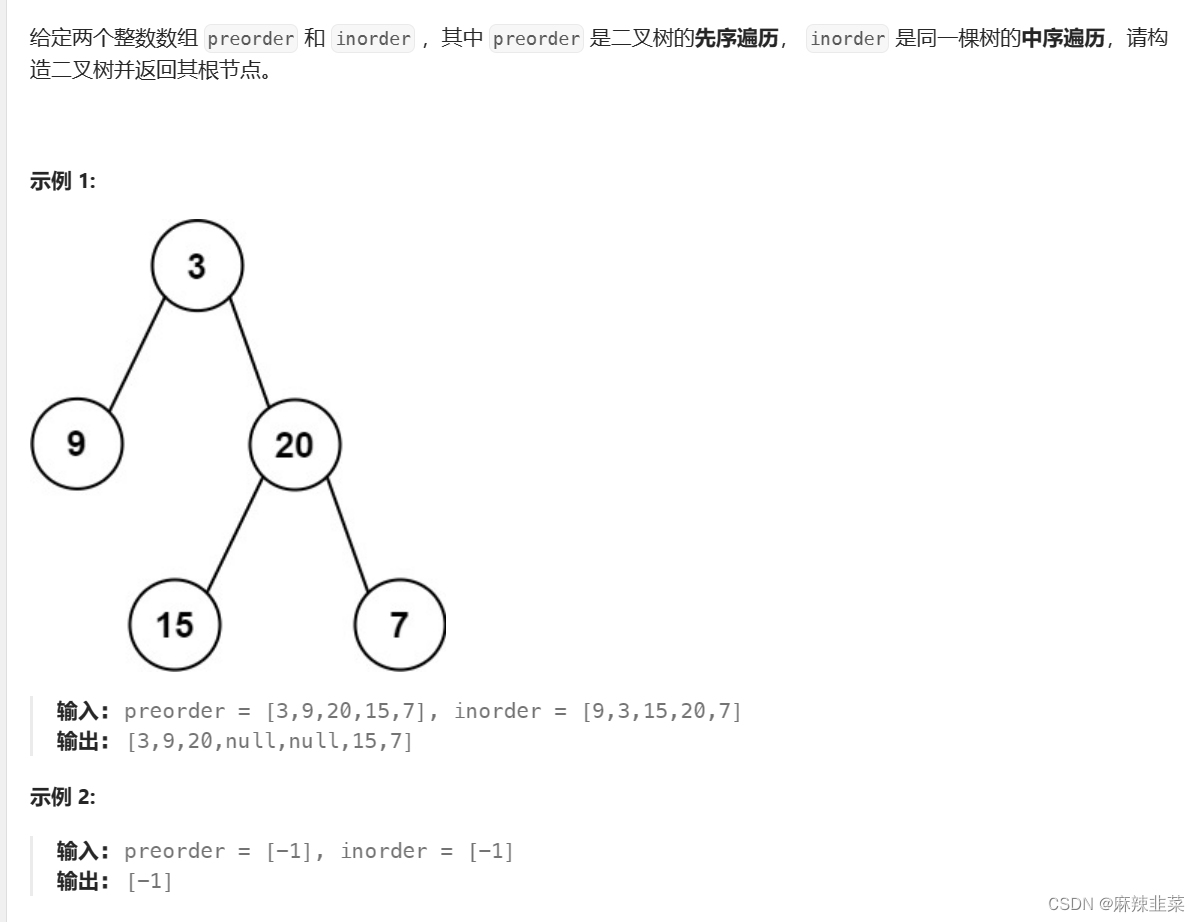
解题思路:前序确定什么? 确定根, 中序确定什么? 确定根的左右区间
class Solution {
public:TreeNode* _buildTree(vector<int>& preorder, vector<int>& inorder, int& prei, int inbegin, int inend){if(inbegin > inend){return nullptr;}TreeNode* root = new TreeNode(preorder[prei]);int rooti = inbegin;//分割区间while(rooti< inend){if(inorder[rooti] == preorder[prei]){break;}elserooti++;}++prei;// 区间[inbegin, rooti-1] prei [rooti+1,inend] //转化成子问题root->left = _buildTree(preorder,inorder,prei,inbegin,rooti-1);root->right = _buildTree(preorder,inorder,prei,rooti+1,inend);return root;}TreeNode* buildTree(vector<int>& preorder, vector<int>& inorder) {int i = 0;return _buildTree(preorder, inorder, i, 0, inorder.size()-1);}
};
7. 根据一棵树的中序遍历与后序遍历构造二叉树。106. 从中序与后序遍历序列构造二叉树 - 力扣(LeetCode)
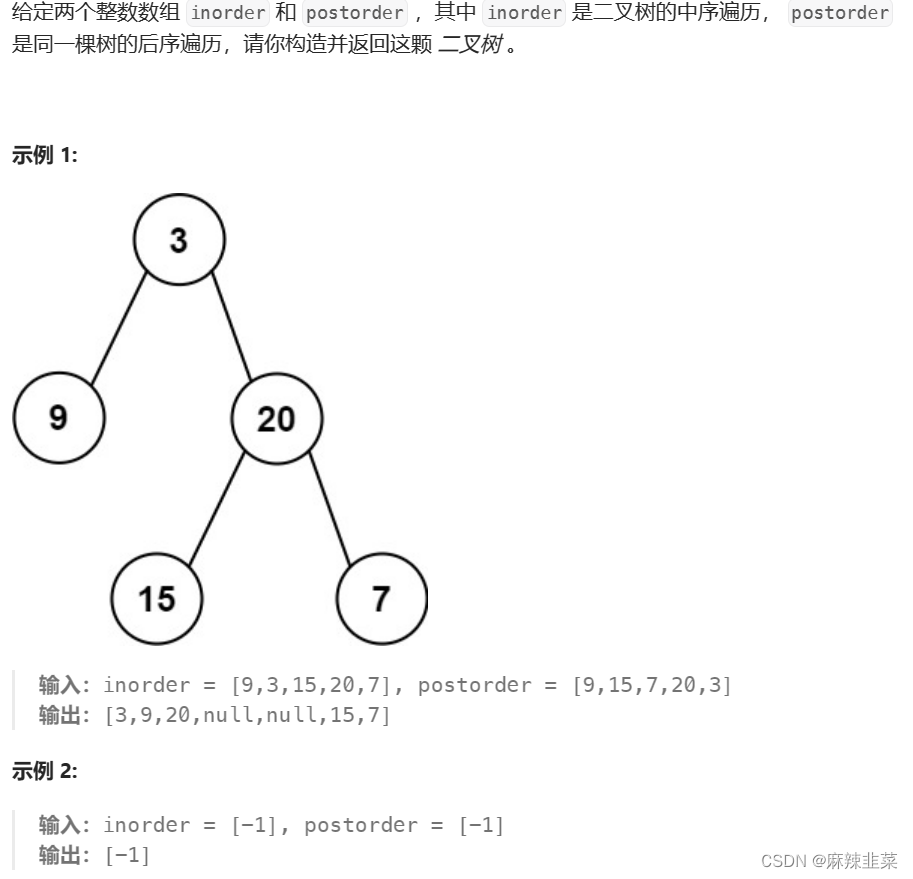
解题思路:还是一样,中序确定根的左右区间,后序确定根。先创建右再创建左
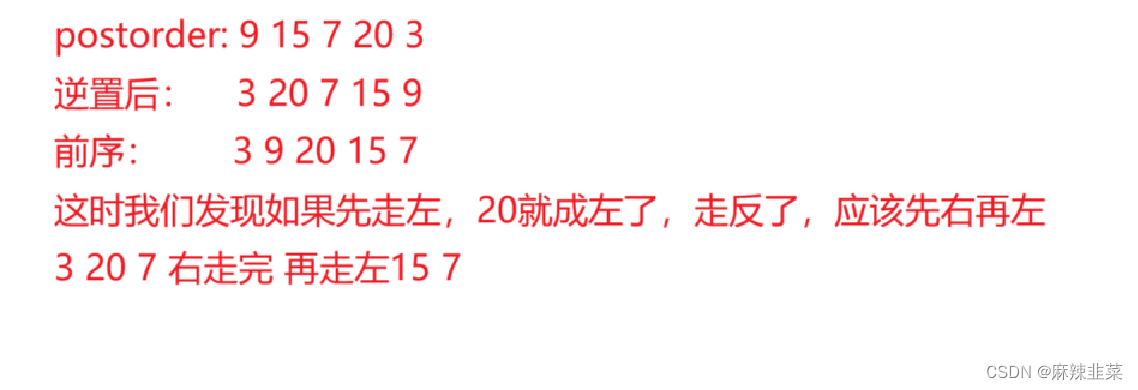
class Solution {
public:TreeNode* _buildTree(vector<int>& inorder, vector<int>& postorder,int& posti,int inbegin, int inend){if(inbegin > inend){return nullptr;}TreeNode* root = new TreeNode(postorder[posti]);int rooti = inbegin;while(rooti < inend){if(inorder[rooti] == postorder[posti])break;else++rooti;}++posti;root->right= _buildTree(inorder, postorder,posti ,rooti+1, inend);root->left= _buildTree(inorder, postorder,posti ,inbegin, rooti-1);return root;}TreeNode* buildTree(vector<int>& inorder, vector<int>& postorder) {int i = 0;reverse(postorder.begin(),postorder.end());return _buildTree(inorder, postorder, i, 0, inorder.size()-1); }
};
8. 二叉树的前序遍历,非递归迭代实现 144. 二叉树的前序遍历 - 力扣(LeetCode)。
class Solution {
public:vector<int> preorderTraversal(TreeNode* root) {//迭代用栈 stack<TreeNode*> s;vector<int> v;TreeNode* cur = root;while(cur || !s.empty()){//开始访问while(cur)v.push_back(cur->val);s.push(cur)cur = cur->left;}//访问右树TreeNode* top = s.top();s.pop();cur = top->right;}return v;
};
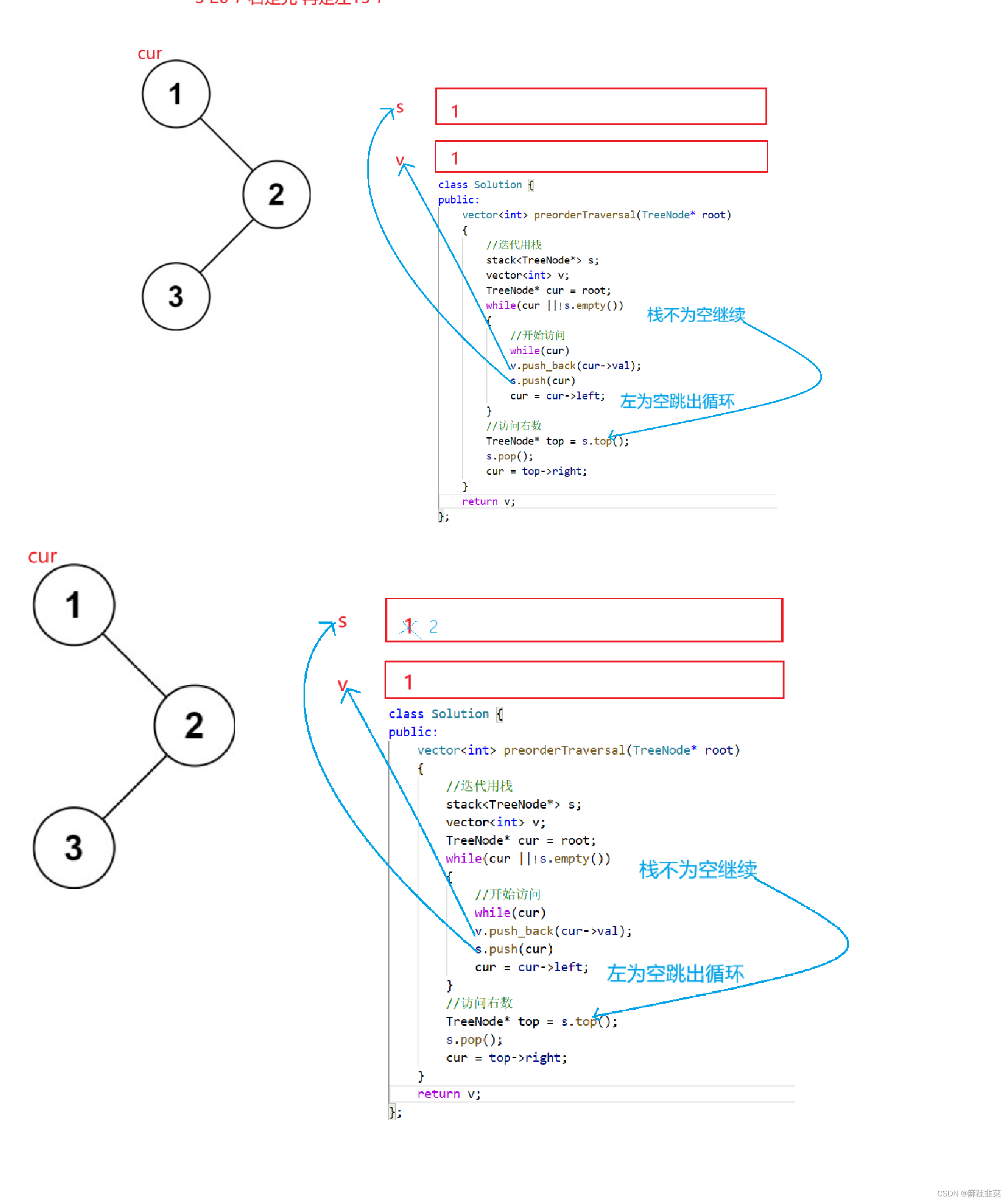
9. 二叉树中序遍历 ,非递归迭代实现。94. 二叉树的中序遍历 - 力扣(LeetCode)
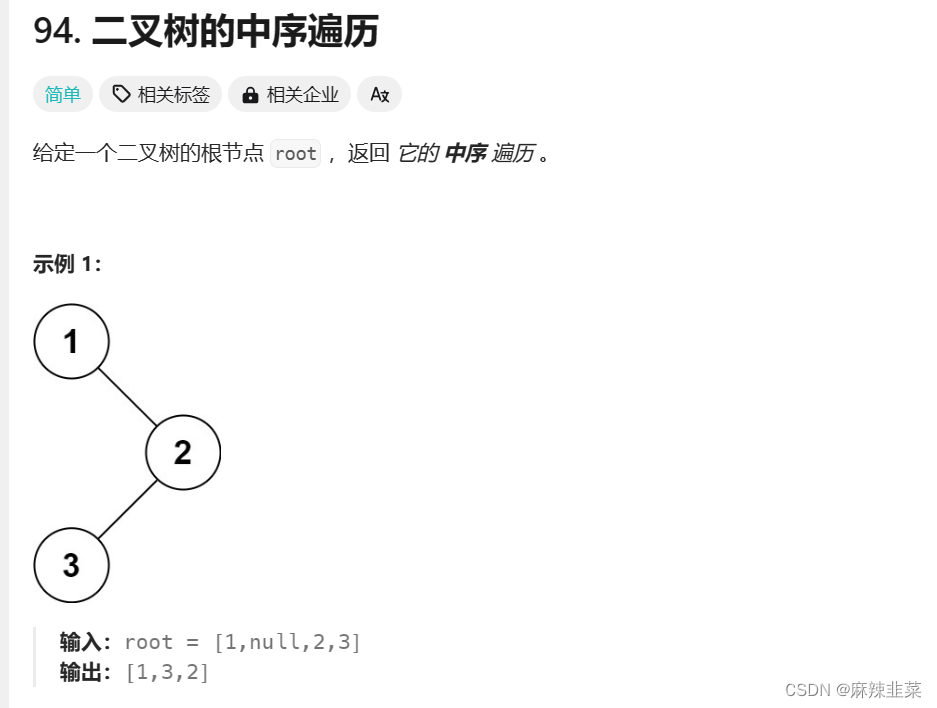
解题思路:和前序不同的是 先访问左 再访问根 然后右。那这样的话 一直迭代到左树为空为止,然后取栈中取元素 push到vector中,最后访问右树。
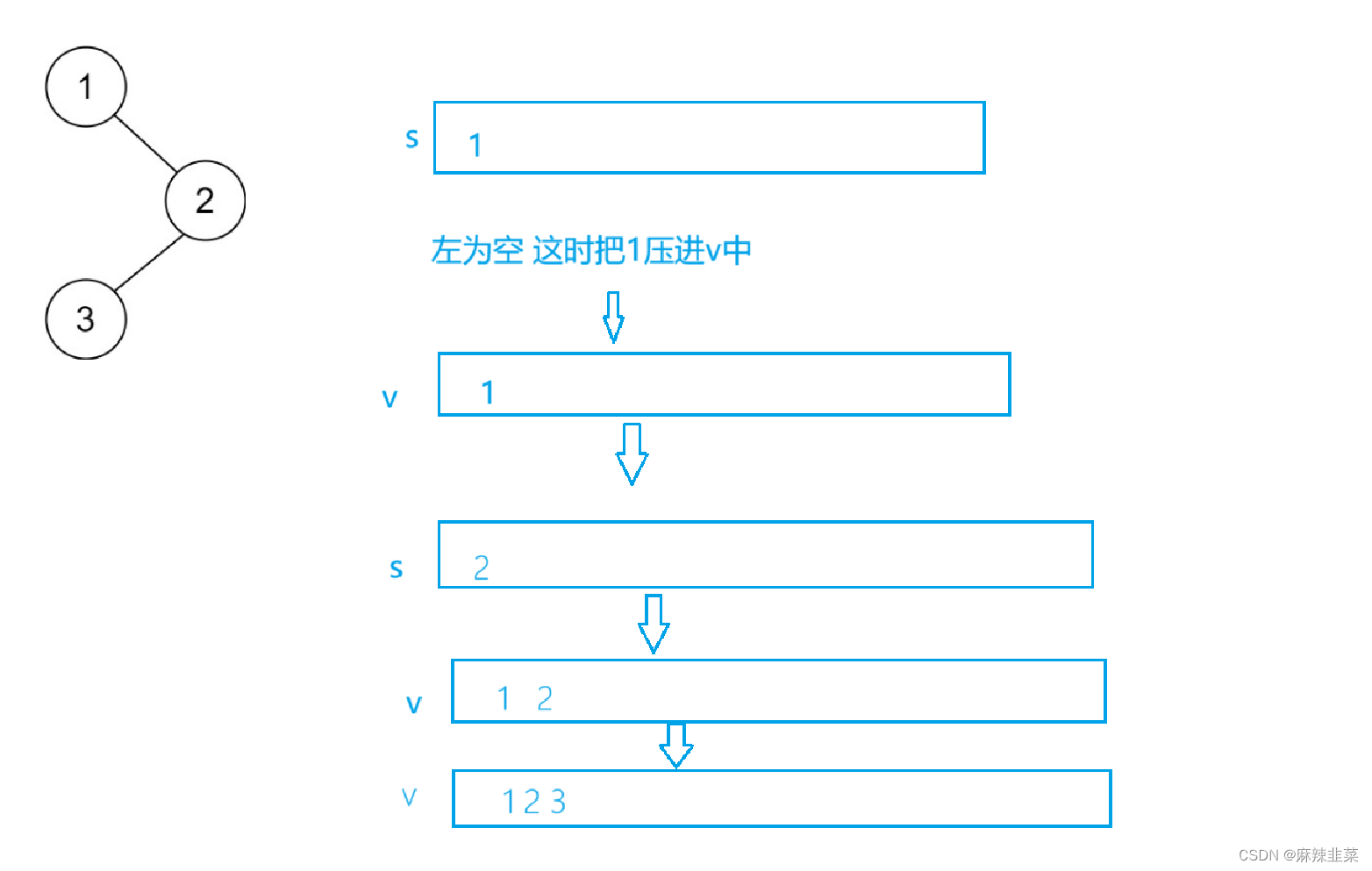
class Solution {
public:vector<int> inorderTraversal(TreeNode* root) {vector<int> v;stack<TreeNode*> s;TreeNode* cur = root;while(cur || !s.empty()){while(cur){s.push(cur);cur = cur->left;}TreeNode* top = s.top();s.pop();v.push_back(top->val);cur = top->right;}return v;}
};
10. 二叉树的后序遍历 ,非递归迭代实现。145. 二叉树的后序遍历 - 力扣(LeetCode)
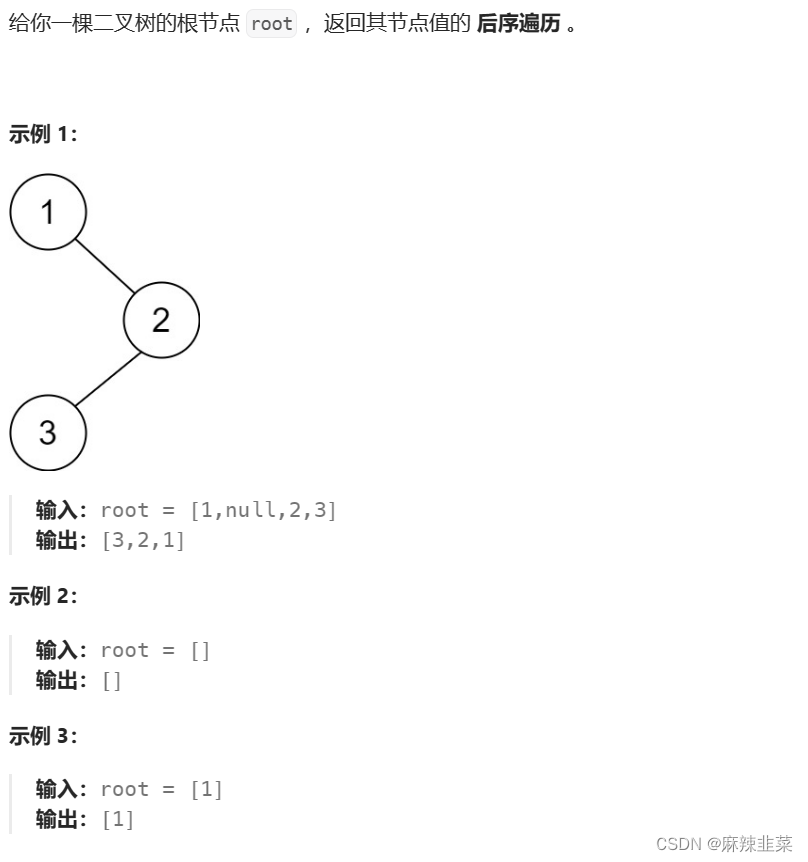
解题思路:后序 先左再右然后根 右为空了再取栈顶的元素,这里不一样的是 如果左右都不空 怎么访问根? 看下图
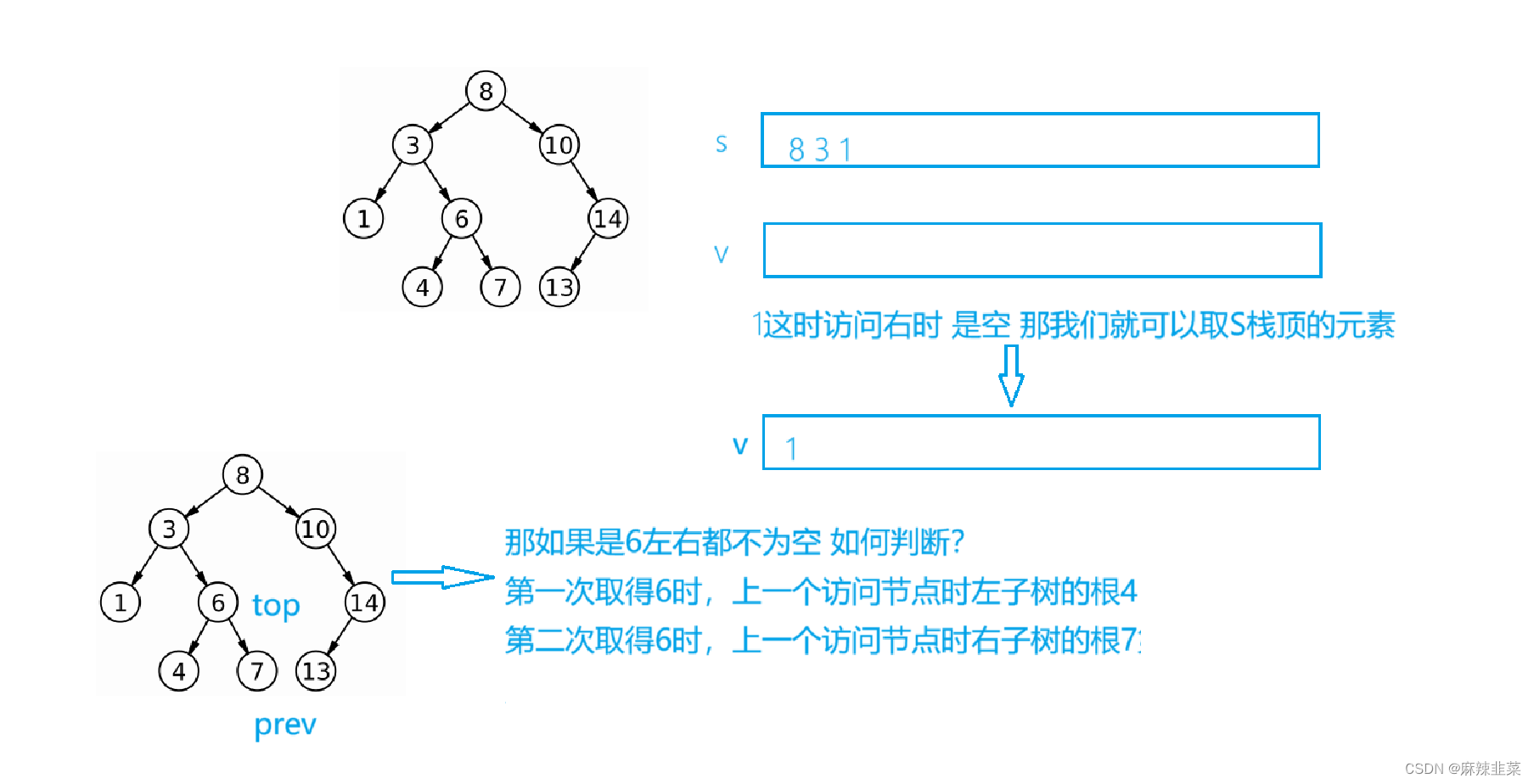
从这个图可以说明 上一个访问的节点如果等于我的右子树的根,那我不就是根吗?
class Solution {
public:vector<int> postorderTraversal(TreeNode* root){vector<int> v;stack<TreeNode*> s;TreeNode* cur = root;TreeNode* prev = nullptr;while(cur || !s.empty()){while(cur){s.push(cur);cur = cur->left;}TreeNode* top = s.top();if(top->right == nullptr || top->right == prev){ v.push_back(top->val);s.pop();prev = top;}elsecur = top->right;}return v;}};
下节预告 map和set 关注我 带你学习更多C++知识!!!!


















)

